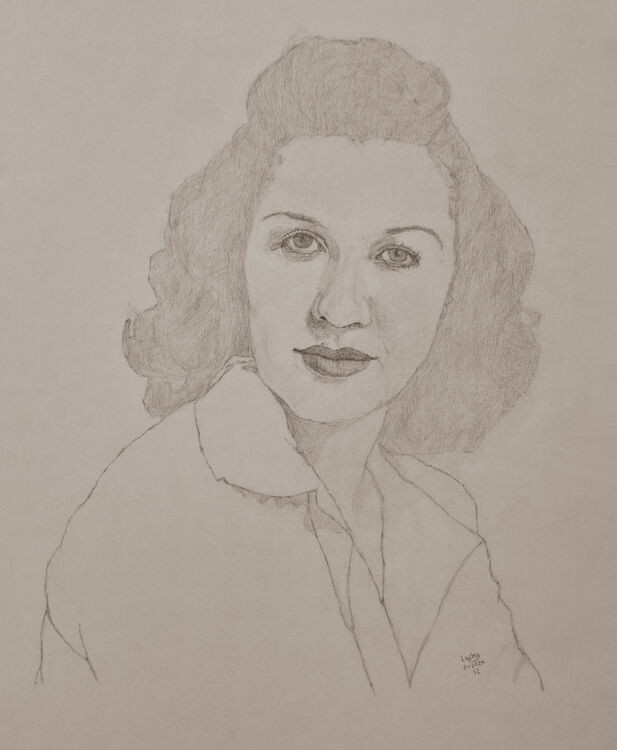
Miriam Kressyn
The lovely Miriam Kressyn immigrated with her entire family to America from Poland in 1923 and settled in Boston, Massachusetts.
As a student, she not only attended summer school and high school, but she also sang in choral classes and attended singing classes given by her teacher. She then won a contest between the best student-singers in the New England Conservatory in Boston and received a scholarship of five thousand dollars to travel abroad to study music.
While the actors Julius and Anna Nathanson were appearing in Boston in Louie Freiman’s “Golden Bride,” they heard Miriam sing, quite by accident.
He then invited her to join the chorus in his theatre, where she sang a solo in the play, “The Golden Soldier.” She then stayed on as a member of the chorus.
In forthcoming guest roles, she played a nurse with the actor Max Gabel in the play the “Bridal Gown,” and afterwards played a young boy in “The Bandit” with Ludwig Satz, and she also acted in the play “Three Brides” with Leon Blank.
She had a walk-on in a children’s presentation of the famous play ”Shulamis,” but she didn’t yet consider the theatre to be her career since she was determined to become a lawyer and was preparing to study at Northeastern University.
In the evenings she continued to sing in the chorus for one season playing incidental roles.
She was brought back to Yiddish theatre by the actor Hymie Jacobson, the brother of Irving Jacobson, who incidentally played the role of “Sancho” with Richard Kiley in the musical “Man of La Mancha,” as well as in many, many Yiddish plays on Second Avenue.
Miriam soon appeared in a more prominent role in Joseph Rumshinsky’s production of “Get Married.”
She then went on the road, appearing with Aaron Lebedeff and Hymie Jacobson in the Lawndale Theatre in Chicago, having equal billing with them.
In 1930-31 she played in Philadelphia’s “Arch Street Theatre” with Hymie Jacobson, and in early 1931 joined the Yiddish Actor’s Union and traveled as guest performer to Boston. In the summer of that year she was a guest performer in Argentina with Hymie Jacobson, whom she married in 1933.
She traveled with him as a guest performer throughout Europe, to such countries as Belgium, England, France, Lithuania, Latvia and Poland.
While she was in Warsaw she divided her time between appearing on stage in the play, “Esther,” and in the Yiddish film "The Jester."
In December of 1933 she played with Maurice Schwartz's Yiddish Art Theatre. but at various times she continued to travel abroad to play on the Yiddish stage, in such productions as Sholem Aleichem's play, “If I Were Rothschild,” among others.
Eventually Miriam and Hymie divorced, and Miriam continued to play in America.
In 1943 Miriam married her fellow Yiddish actor Seymour Rexite and appeared with him in various theatres in New York City, such as the National, the Public, and the Second Avenue Theatres, and she was also an acting partner with such Yiddish theatre greats as Menasha Skulnik, Michael Michalesko, Irving Jacobson and others.
Miriam also appeared on the radio in the “Forward Hour,” starring in well-known plays that were performed on the radio.
For many years she had her own programs as a singer and commentator on radio station WEVD, where she was in charge of writing her own book reviews, holding conversations with famous personalities and guests, and commenting on different social issues.
She also had an original radio program, “Meet up with Miriam Kressyn,” where she discussed a variety of worldwide commercial undertakings.
Kressyn also appeared on Yiddish-English television over a period of four years, together with her husband Seymour Rexite.
Miriam Kressyn had a beautiful voice and performed in musicals, whose music was written by some of the greatest composers for the Yiddish theatre, such as Joseph Rumshinsky, Alexander Olshanetsky, Abe Ellstein and Sholem Secunda, all of whom she was close friends with.
For both Miriam and Seymour, they made it their mission to capture the history of the Yiddish theatre and educate their audience about the influence it had on the American theatre and musical scene.
This they often did on their WEVD radio show.